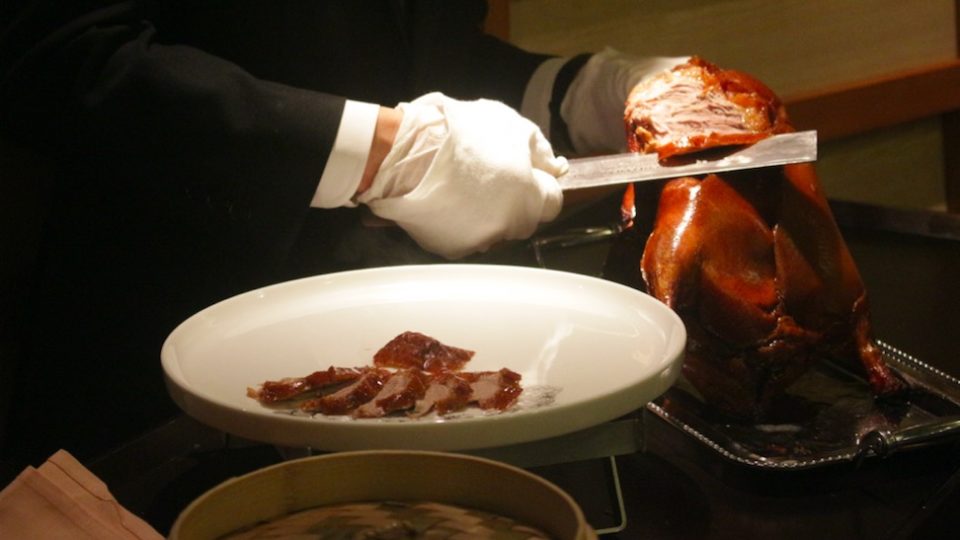The thing that strikes you as a first-time diner at Peking Garden is just how much everything has a sense of theater — from the elaborate plating and presentation of many of the dishes, to the la mian (hand-pulled noodles) show that happens every night at 8:30pm, performed to the dramatic tunes of George Lam’s A Man Should Strengthen Himself. It’s basically the kung fu film equivalent of Eye of the Tiger.
Dramatic? Yes. Are we kidding? We kid you not.
As one of the more than 20 outlets that comes under the Maxim’s Chinese Cuisine umbrella — sister restaurants include Jade Garden, Chiu Chow Garden, and Maxim’s Palace — it’s easy to dismiss Peking Garden as just another one of those generic Maxim’s-owned restaurants that serve average food at extortionate prices.
The Chinese banquet hall has been a go-to restaurant for families, celebrations, and business entertaining ever since it opened in Tsim Sha Tsui in 1978. It recently celebrated its 40th anniversary, and not unlike an F&B version of a mid-life crisis, the milestone was marked with an extensive makeover, both in its interior design and menu.
For those who have never had old school Beijing banquet-style dishes, just think about what an emperor might feast upon. Aside from the usual suspects (namely the Peking duck), there are elaborately plated and sculpted dishes — designed to show off the chef’s craftsmanship — that make Peking Garden the ideal place for anyone who wants to up their foodstagram game.
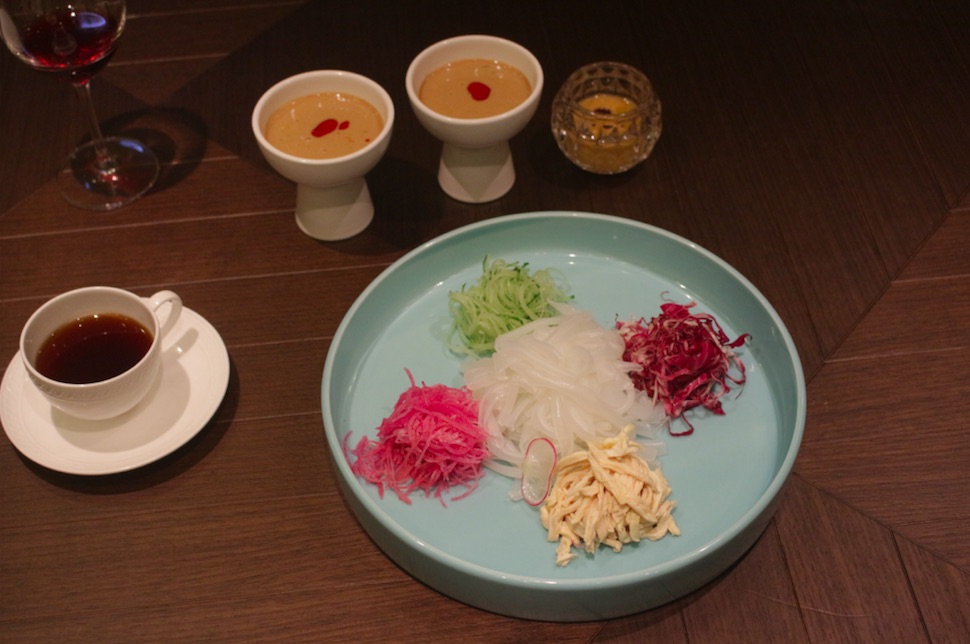
We started off the meal with a rice noodle served with shredded chicken, cucumber, red cabbage, and purple turnip in sesame sauce (HK$108), a nice, not-too-heavy starter, with a delicious and surprisingly light nutty sauce that really brought the whole dish together.
But our attention was drawn to the cucumber spiral in the middle of the table. Cucumber in lime served with pomelo and chili sauce (HK$88), it’s called, and it’s exclusive to the Tsim Sha Tsui location. Starring a single cucumber that has seen more than 100 slices into its flesh, then wrapped around itself to form a snake sitting in a spiral. It’s art, man.
As for the taste itself — nice and refreshing, though because the cucumbers were sliced so thinly, there were bits that didn’t get flavored with seasoning, and felt a bit dry to chew. That said, the pomelo and chili sauce was great — slightly sweet, not too overpoweringly spicy, and doesn’t leave that lingering spicy aftertaste. In fact, the spicy aftertaste disappears quite quickly.
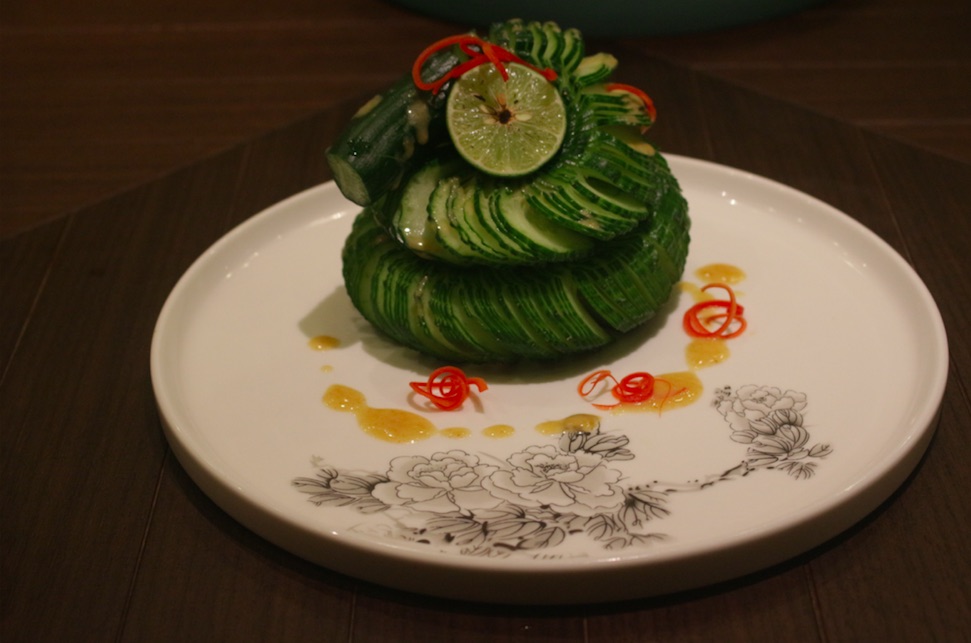
Moving on to the main meatier dishes. We started with the sautéed prawn with scallop and sea whelk with chili sauce, which was served with the most elaborate carrot carving we’ve ever seen in our lives: A detailed dragon, which the restaurant staff tells us, takes five hours for chefs to carve by hand.
There was also a bit of mashed potatoes (a decidedly not conventional ingredient to add to a Beijing banquet dish) on the side.
We particularly liked the thick juicy prawns that came with this dish, and the sauce again struck that balance of being sweet, sour, and just spicy enough to not leave the lingering aftertaste. Surprisingly, this worked with the creamy mashed potato.
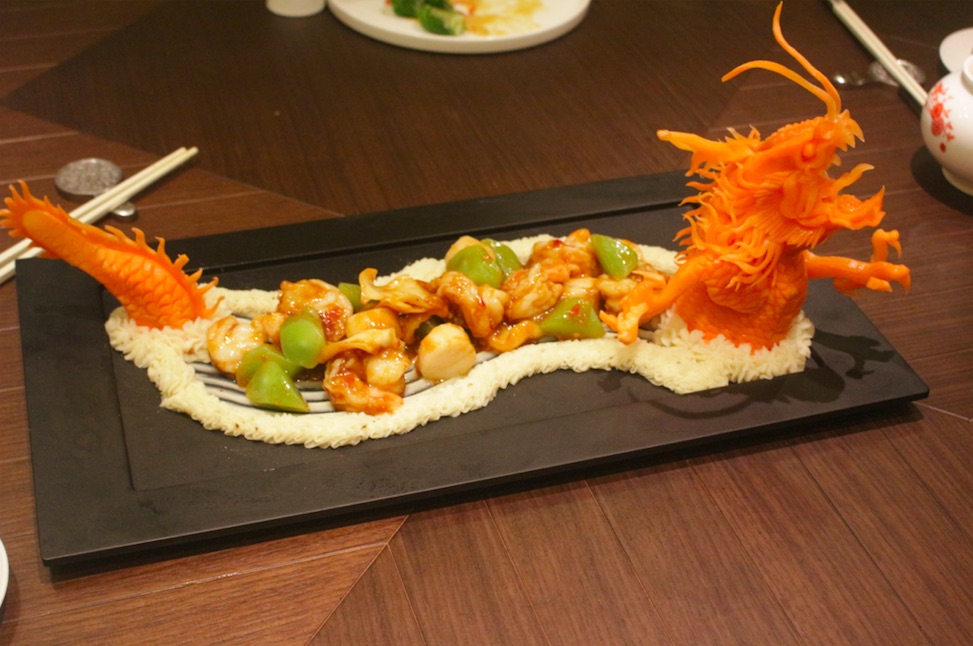
Wait. The price tag on this dish, which is exclusive to the TST branch, did give us pause. We love theater and all, but this one’s gonna cost your table HK$780 per plate. Think of yourself as some kind of patron of the arts, then, because you’re most certainly paying that figure for the amount of work that went into that dragon carving than the actual parts of the dish that you’ll be eating.
Two things to note, in case you do decide to spring for this dish: one, you have to pre-order it in advance. Two, disappointingly, is that you’re not supposed to eat the dragon carrot. For display purposes only, we’re told.
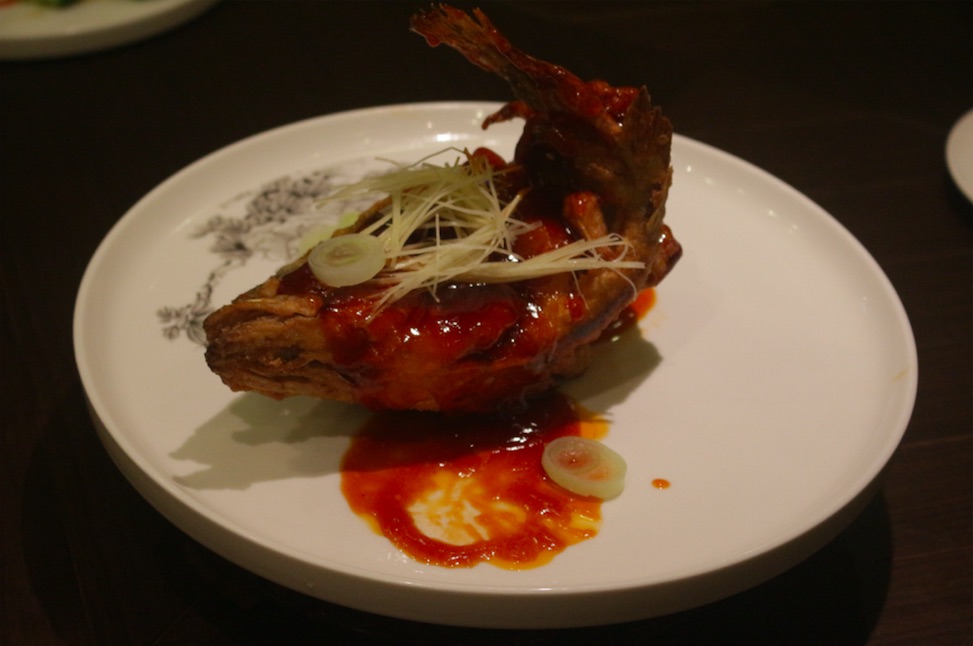
A seafood dish that we did enjoy was the deep-fried mandarin fish (HK$298) — distinctive, mainly, because it’s fried in such a way to resemble a fish jumping out of water. It’s tossed in sweet and sour vinegar sauce, which struck that balance between sweet and sour very well.
The fish was very tender, very good. It’s not a very large size (the meat is just enough for about two to three people) so our table of six people only had a few bites each.
But, at this point, we were wondering “Where’s that Peking duck?” And as if she heard our whispers, in came the star of the show, in all her silver platter glory.
The kung fu film music plays overhead — but, we find out that that’s only because one of the chefs began a noodle-pulling show at the same time, so it’s merely a coincidence that the duck is being presented to this soundtrack.
It’s OK. We got the dramatic duck presentation of our dreams, and we don’t care if it was planned or not.
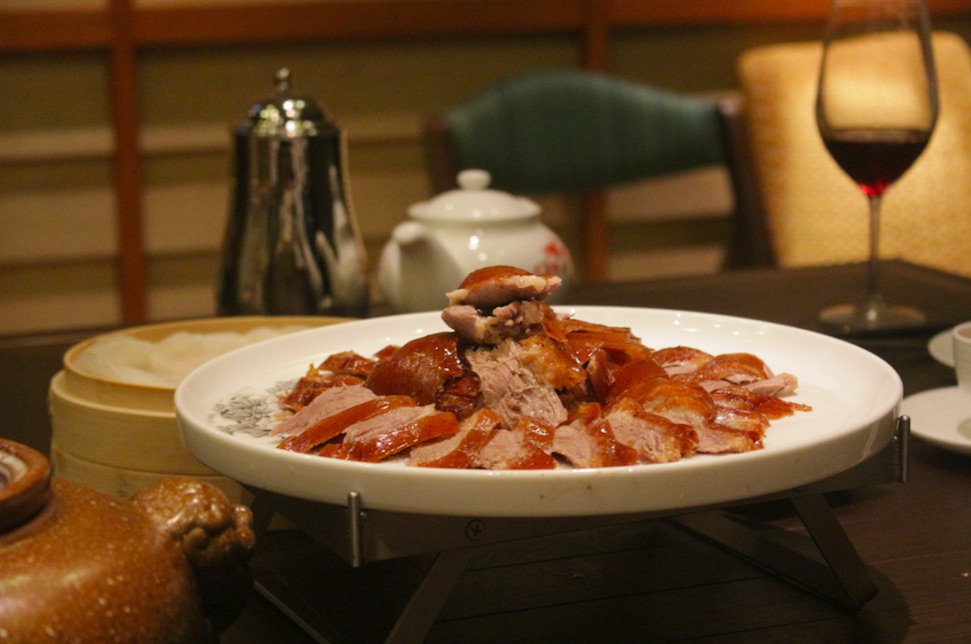
So, the verdict: A nice, tender duck with delightfully crispy skin that isn’t too fatty, and that’s also noticeably less oily than other Peking ducks that are served in similar restaurants in town.
The thin, savory pancakes that come served with the duck are also considerably less oily too, so no scrambling for napkins or wet wipes to clean up off any excess oil on your fingers after you’ve devoured your duck in pancake with scallions, cucumber, and hoisin sauce.
The prices — HK$460 for a whole duck, and HK$240 for half — are reasonable, too.
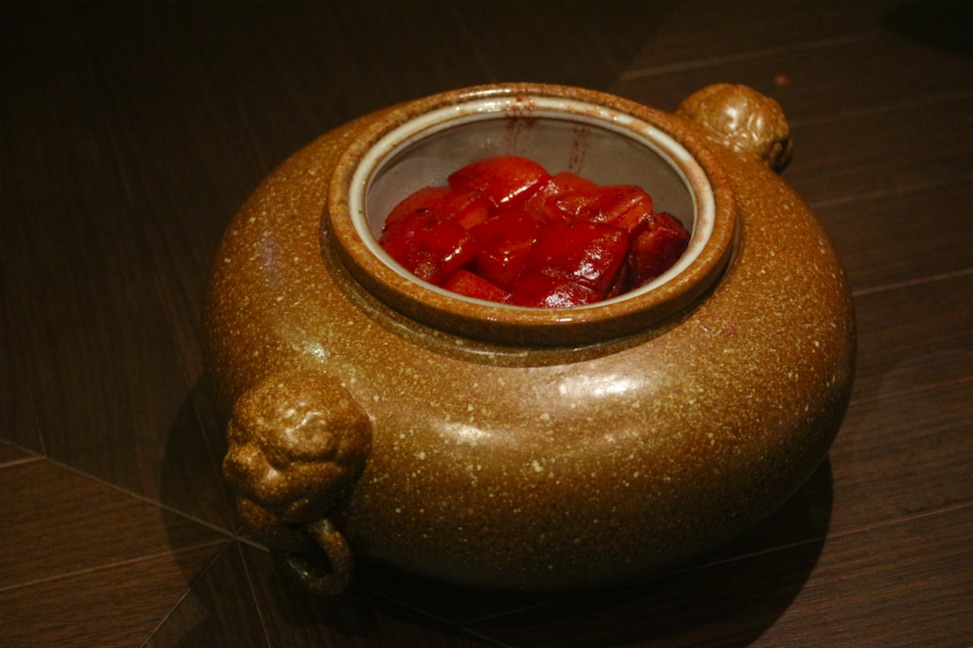
The restaurant’s braised pork belly (HK$158) was also one of the standout dishes of the evening; tender, lean melt-in-your-mouth pork that was savory and sweet.
Another showstopper: the beggar’s chicken (HK$580).
There isn’t a consensus as to which part of China this dish comes from, and how it came to be (some legends say a beggar improvised the creation of the dish, while others say the emperor added the dish to the imperial menu after eating it alongside a beggar) — but it’s a favored banquet dish for good reason.
The chicken is stuffed with a number of differently textured, distinctively flavored ingredients, and wrapped in lotus leaves. That’s then wrapped in clay, and then the whole thing gets slow-cooked for a few hours until it yields a beautiful end product where meat just falls off the bone.
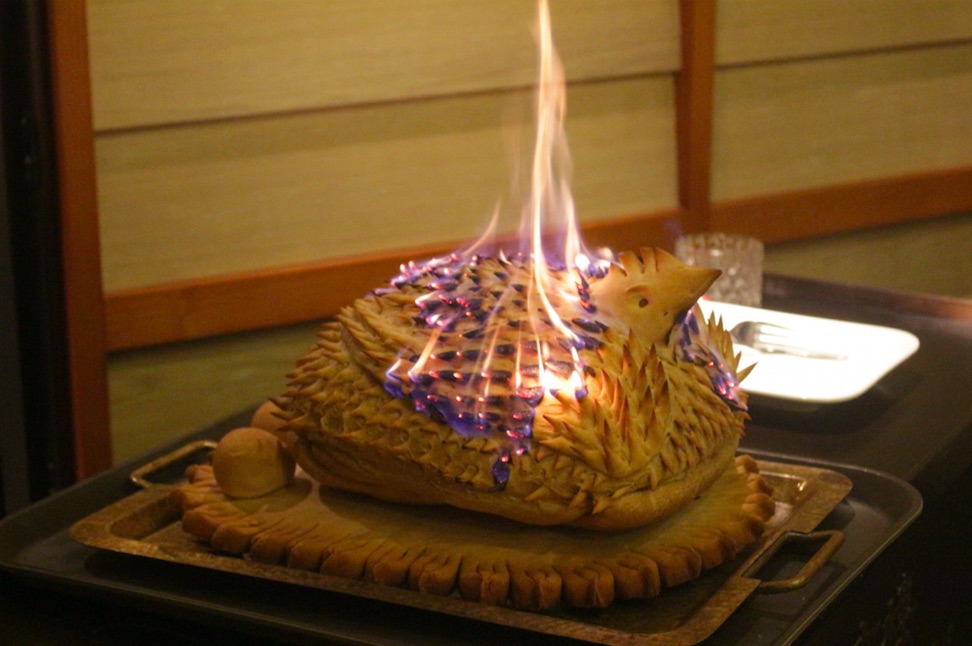
Peking Garden’s iteration of this less-than-humble dish is stuffed with abalone, whelk, and mushroom, and placed inside an elaborately carved chicken (or phoenix? We couldn’t tell, someone at our table first thought it was a hedgehog).
A waiter then comes in, douses the clay animal with rose liqueur, and sets the whole thing alight. You, the guest, do your obligatory oohs and aahs, and the waiter then puts the fire out, followed by an invite to one of the diners to come over and crack the thing open with a golden hammer. Then, and only then, is the dish served.
We were previously told that you can get a special mini gold hammer and a polaroid photo to take away as a souvenir, but alas, we left empty-handed. Maybe next time.
The meat was tender, and was still piping hot when we ate it. There’s really quite a lot going on in this dish, so if you’re a chicken purist who really wants the original flavors of the meat to shine through — then this isn’t that. If we had to characterize the flavor profile, we’d say savory. In a generic sort of way.
Like that carrot dragon, this is another dish that needs to be ordered in advance. Though, if we’re comparing the two, we’d say this one was less about taste and more about the spectacle.
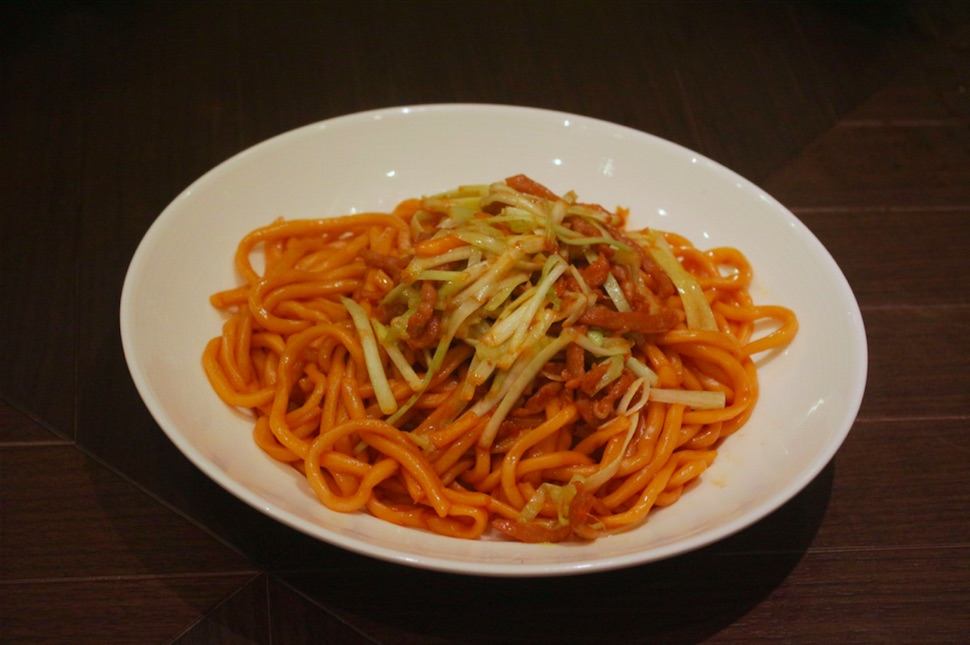
It’s also worth noting that while the evening was all about the show-stopping banquet dishes, simpler items like the sautéed shredded bamboo shoots in chicken broth (HK$118) and Peking fried noodles with shredded pork (HK$118) were very good. Plus, dishes like these are great in balancing out the more elaborate dishes when you’re feasting emperor-style.
For dessert, we tried the deep-fried glutinous puff with water chestnut (HK$72 for six pieces) and baked mashed apple pastry (HK$45 for three pieces).
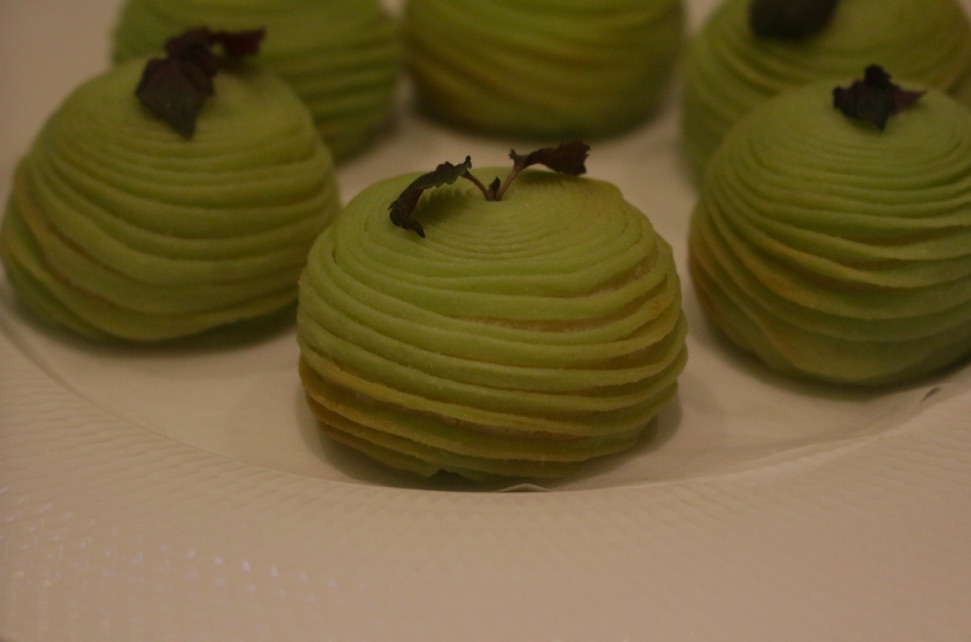
The mashed apple pastry had a sweet and slightly sharp apple center encased in a cute green apple pastry. The glutinous puff, which was chewy, not too sweet, and had a bit of honey poured on top for an added bit of sticky sweetness, was far tastier and satisfying than the apple pastry.
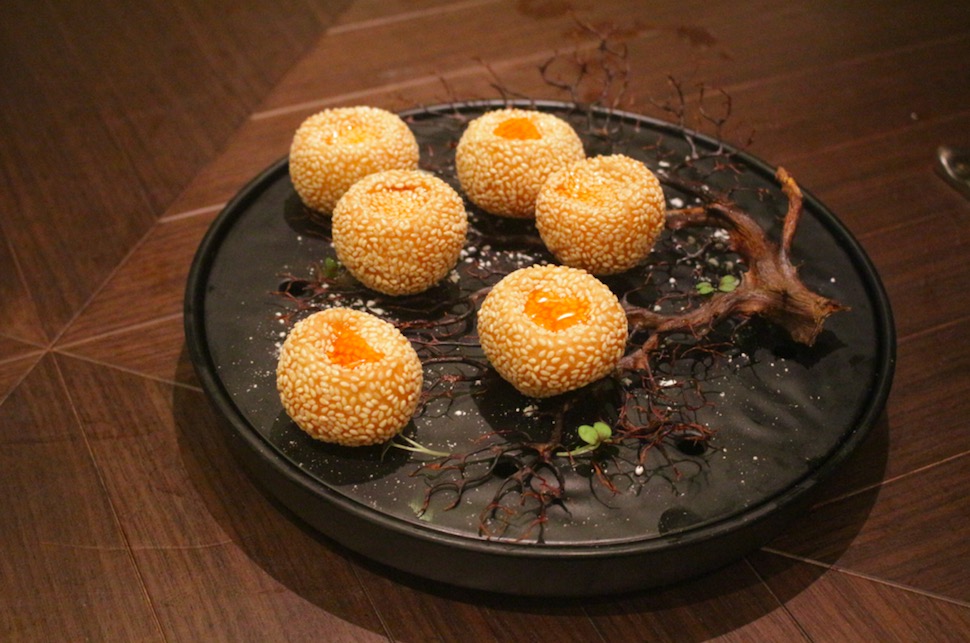
Including the TST outpost, Maxim’s has six Peking Garden restaurants (Mong Kok, Central, Admiralty, Kwai Fong and Yuen Long), but some of the dishes here are only exclusive to the TST branch.
Notwithstanding that carrot dragon, the price tag of which nearly made our eyes pop out of our heads as we processed the sheer absurdity and excess involved — we really enjoyed our time here. It’s a little showy sometimes, sure, but that kind of atmosphere is what old school banquet hall dining is about. It’s great if you keep an open mind about it.
So, people that you should bring: family, colleagues, wedding guests. People that you probably could bring but might want to think twice about: that one friend who insists on taking photos of every dish and won’t let anyone eat until the “right shots” are captured.
FIND IT:
Peking Garden is at 3/F, Star House, Tsim Sha Tsui, Kowloon
Reservations: +852 2735 8211
Mon-Sun, 11:30am-3pm and 5:30pm-11pm
MTR: Tsim Sha Tsui (approx. 5 minute walk)
